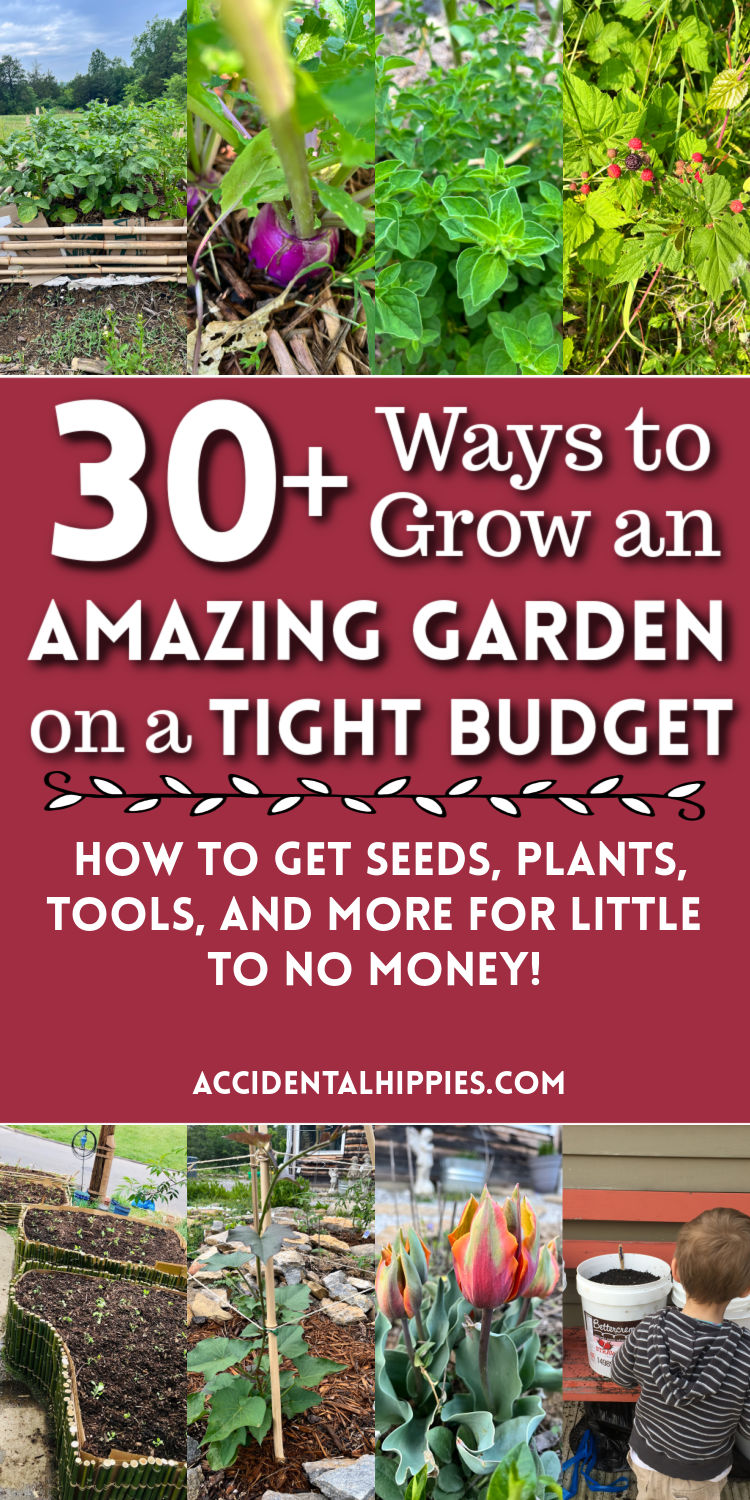Disclosure: I sometimes earn products or commissions from affiliate links or partnerships on my blog. I only recommend products and services I trust to serve you. Learn more.
If you’re anything like me, you probably want to grow a food garden because it’s enjoyable. You love digging in the earth. You love watching seeds come to life and turn into something delicious.
But gardening isn’t typically a free venture. It’s so easy to go to the garden center and spend a small fortune on soil, compost, seeds, starts, tools, planters, and so on.
So how are you supposed to be able to save money growing your own food?
The good news is there are dozens of ways to reduce the cost of growing a food garden. Whether you’re a new gardener or a seasoned veteran, have acres of healthy soil, or an apartment patio, here are 30+ of the best ways to help you grow your own garden on a limited budget.
30+ Ways to Start a Garden for Cheap or Free
Choosing a Cost-Effective Garden Method
The best garden method for you is one that:
- fits the size and type of space you have
- will accommodate the amount of time you have available to tend it
- uses materials that you have or can easily source for little to no money
This will vary for every garden situation. After all, the kind of garden someone in a patio home can grow will be wildly different from what someone with a one-acre flat yard can grow.
Take some serious time to assess and plan your garden with this post first and then use the tips below to help you source everything from tools and supplies to seeds, starts, and materials.
READ: 12 Tips to Plan Your Best Garden This Year
Some of my favorite garden types that maximize yield with minimal materials are:
- Square-Foot Gardening
- Hugelkultur
- Back-to-Eden
- Container Gardening
- Edible Landscaping
There are LOADS of methods out there, so fear not! There is a method for you!
Cheap or Free Garden Tools and Supplies
Garden tools are something you can easily spend a small fortune on. A wheelbarrow alone is often over $120 new for something that looks like it’ll fall apart within the next year.
If you’re working with not a lot of money, the thought of spending cash on a wheelbarrow, shovels, rakes, garden spades, trowels, watering cans, hoses, and on and on and on…it can be overwhelming. The good news is that it’s pretty easy to get great garden supplies for next to nothing. Here are some of our favorite ways to get materials:
Local Buy-Nothing Groups
I typically find these kinds of groups on Facebook but that’s just one place to start. You can sometimes find buy-nothing groups by doing an internet search like “buy-nothing groups near [YOUR LOCATION]”. You may even see groups like this advertised on bulletin boards at the library or in other community spaces. Who knows what other unexpected places!
Facebook Marketplace and Craigslist
I am a big fan of getting cheap or free items from local folks via Facebook Marketplace or Craigslist. I’m pretty sure we built half of our house with materials and items we found on one site or the other. The nice part of FB Marketplace is seeing exactly who you’re dealing with and if you have any mutual friends. Craigslist is a little more anonymous, which has its pros and cons.
Cooperative Extension Office
US Residents may be familiar with their local cooperative extension office.
If this is unfamiliar to you, the Cooperative Extension System is a nationwide program that pairs the resources of the US Department of Agriculture with state universities and organizations to reach farmers, ranchers, gardeners, and folks of all stripes at the local community level.
Local cooperative extension offices often have educational and material resources available to anyone, including soil testing, plant identification, equipment rental, and more.
Our local extension office will often do programs where the first 50 registrants receive a free item. For example, registering for a 1-hour class on home composting can get you a free compost tumbler to take home.
You may have access to these kinds of programs in your area too, so be on the lookout. I recommend anyone in the US check out their local extension office. If you are in a different country, check to see if there is an equivalent program in your area. You may need to search via a Ministry of Agriculture or something similar to the USDA.
City and Regional Programs
Similar to a cooperative extension, some municipalities are very generous with gardening resources.
For example, the city we lived in before building our off-grid home had a free rain barrel program. Another rural town we lived in years ago had a hub near the city park that housed the community recycling center, community compost, and free mulch program.
I recognize that not everyone is so fortunate to live in an area that values programs like these. After all, it’s been over 16 years since we lived there and, even though it was a relatively small town in the foothills of the Appalachians, I haven’t gotten to live in a place with such robust sustainability programs since. Still, it is worth a little digging to see what’s out there in your area.
Thrift Shops
Don’t think thrift shops/charity shops are just for clothes! You’d be amazed at what you can find in some thrift stores. I once scored an awesome canvas gardening tool bag with a trowel, spade, hand rake, and a weeding tool for just a few bucks and they’ve lasted me for YEARS.
Tool Lending LibrariesThese are becoming increasingly common, so keep an eye out! Tool lending libraries are just like book libraries but, obviously, for tools. These are sometimes managed by your local library system, while others are independently operated.
Lending libraries can be a great option for borrowing specialty tools that you may not need so often, like a roto-tiller or edger. Of course, you can usually borrow smaller tools like shovels and rakes too.
Friends and FamilyI would be remiss if I didn’t mention borrowing from friends and family. Sure, it’s nice to be able to get things independently, but in our societal quest for “self-sufficiency” it’s easy to forget the role of community. Start with those closest to you. If they are gracious enough to lend to you or even gift something to you, remember to be a good steward of that gift.
We have acquired so many tools and materials simply by asking the people we know. Sometimes, even just them being aware of something you’re interested in will help eventually. That’s how we got our wheelbarrow even though we weren’t looking for one at the time.
Yard SalesYard sales (or garage sales/rummage sales/tag sales/jumble sales…whatever you fancy calling it) can be a goldmine if you can get out early and scout some deals. This can be hit or miss, but it isn’t to be overlooked.
Estate Sales
We’ve had more luck at estate sales than yard sales. This is typically because most folks are still using their garden equipment and aren’t necessarily keen to sell it at a yard sale unless they’re trying to downsize. But an estate sale is the sale of everything in the estate, and that usually includes everything in the garden shed. We went to one a few years ago that had a LOT of garden and building materials out in the detached garage. Some things were more useful than others, but if you get to an estate sale early enough there is usually quite a bit to choose from.
Farm AuctionsDepending on what you want, a farm auction can be a great place to score deals on equipment. This would not be my first stop if you only need some shovels and a wheelbarrow. But if you’re looking for a tractor or planting gear for your homestead on the cheap, farm auctions can be a great place to look.
If you’re just getting started, try going to a site like Auction Time and selecting your local area to see what’s available. You might be surprised at what you can get!
Antique Malls and Flea MarketsAntique malls and flea markets aren’t just for vintage furniture or decor. You can sometimes come across interesting and useful tools for your home and garden too!
Be sure to thoroughly examine any tools and implements you find for quality and condition. You don’t want to get something that is rusted or that potentially contains lead, for example.
You also have to be wary of items that purport to be vintage but are actually just modern mass-produced junk put there to pad out their inventory. In those cases, what looks like a deal may not really be one.
Another note about antique malls and flea markets is that they can often be a great place to find gardening books. Sometimes the books are modern but dated (think 1970’s and later), but still have great gardening wisdom in their pages.
Antique malls in particular can have great vintage botany books that are perfect for the aspiring garden nerd. I know I’m one to geek out over antique books with detailed hand-drawn illustrations. I love seeing how people a century or more ago thought of the home garden and what knowledge they had that could potentially be applied today.
Cheap or Free Seeds and Plant Starts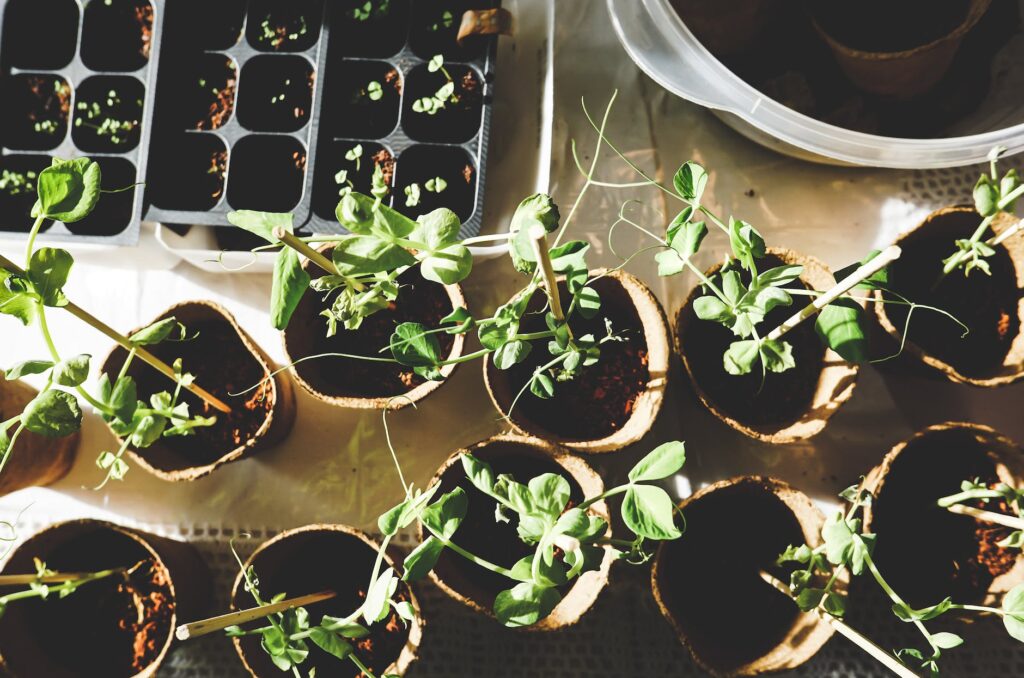
Buying seeds is touted as the cheapest way to start a plant, and while that is technically true on the seed level, it doesn’t take into account the need for containers, soil, light, and heat. The good news is there are many ways to start seeds for free or very low cost. Even better news is you can skip straight to plant starts if you know what to look for.
Find seed swap groupsLocal garden clubs can be a good place to acquire new seed packets. I’ve personally found them via friends, notices on bulletin boards at the library or hardware store, or even on social sites like Facebook. Try to stick to local seeds that you can trust to produce well for your area. Joining a big national seed swap group online might sound fun and interesting, and it certainly can be! But if you’re a grower in an extreme northern hardiness zone trying to grow a seed meant to thrive in the deep south, you’re going to have a hard time.
Local library seed swap eventsSimilar to the above, local libraries often put on seed-swapping events. Sometimes, library programming will also offer growing classes geared towards gardeners of varying abilities. Offerings vary from place to place, but it’s worth checking to see if any libraries in your area offer events like this!
Check with friends, family, and neighborsYou’d be surprised how many plants I’ve snagged from friends, family, and neighbors who were giving them away. Sometimes they had a plant that needed dividing and had nowhere to put the discards. I’ve had friends post on their social pages that they had seeds of varying types to give away. You never know what you might come across! If you have someone in your life who you know has a garden, tell them you’re interested in getting started for yourself. Chances are good that they will want to share their knowledge with you and may even be willing to share some resources to help you get started.
Use containers you already have or make cheap ones
You may think you need proper seed-starting trays and pots to make the most of your gardening efforts, but truthfully, plants aren’t super picky if you’re on a limited budget. I have started seeds in everything from:
- milk jugs and cartons
- juice boxes
- yogurt cups and tubs
- old ice cube trays
- egg cartons
- jars
- plastic cups
- DIY newspaper pots
Don’t be afraid to experiment to see what different plants do in different types of containers. Chances are they’ll turn out just as well as if you bought pots from the store.
Rescue plants from the big-box storesYou would be appalled to see the kinds of plants that are often thrown out at the big-box hardware stores. Into the dumpster. Not composted. Not set out and marked “Free”. Thrown into a dumpster and sent to a landfill.
It makes me cringe.
The best place to start is to find an employee in the local garden center at your nearest chain hardware store and ask, “What plants are you guys getting ready to throw out? And can I have them?” You may also consider talking to the garden center manager to see if you might make arrangements for taking damaged and discarded plants at specific times in their inventory cycle.
As an introvert, the only thing that makes me cringe more than sending plants to a landfill is having to talk to an actual human being to rescue those plants. But rescue, we must. So set aside discomfort and do the hard thing.
I have a relative with zero qualms about walking up to a random employee and asking questions. This relative then showed up at my house with several rescued pots of oregano and spearmint, all of which are still alive and thriving several years later.
Grow from kitchen scrapsAn easy way to get free plants often comes right from the food we already have. For example, last year my mom removed an old package of basil from her work fridge. She didn’t really want it but knew I liked basil, so she brought it to me. When I opened the package, all of the basil stems had little roots sprouting all over. I didn’t want to waste the opportunity, so I put the stems into some little cups of water to let the roots grow out a bit, and then I transferred them to my garden. That sad little back-of-the-fridge basil that was left to die in the breakroom refrigerator ended up producing several bush-sized plants in my garden. I managed to dry about four cups of crushed basil from them and used a TON of it fresh through the summer.
There are loads of other plants you can grow from kitchen scraps, including but not limited to:
- Celery
- Herbs
- Garlic
- Ginger
- Sweet Potatoes
- Green onions
- Lettuce
- Peppers
Some plants are better to grow from scraps than others. For example, sweet potatoes are easy to grow from slips off a single sweet potato. I’ve been harvesting from the same sweet potato lineage for years now. But white, yellow, Russet, or similar potatoes are best if started from disease-free seed potatoes to avoid issues. Research the specific foods you’d like to try growing your own vegetables from scraps to find the best practices for each of them.
Grow from cuttingsSimilar to growing from scraps, growing from cuttings can be a great way to get your own plants from older established stock. This is best for growing woodier plants like berry bushes and fruit trees.
It’s best if you can obtain cuttings from someone you know and trust. Taking cuttings from wild raspberry canes at the local park may sound nice, but there can be issues in terms of conservation efforts or potential pesticide usage. Know your source.
This article from Tree Plantation goes into some of the basics of plant propagation to help you get started.
Cheap or Free Soil, Compost, Mulch, and Soil Amendments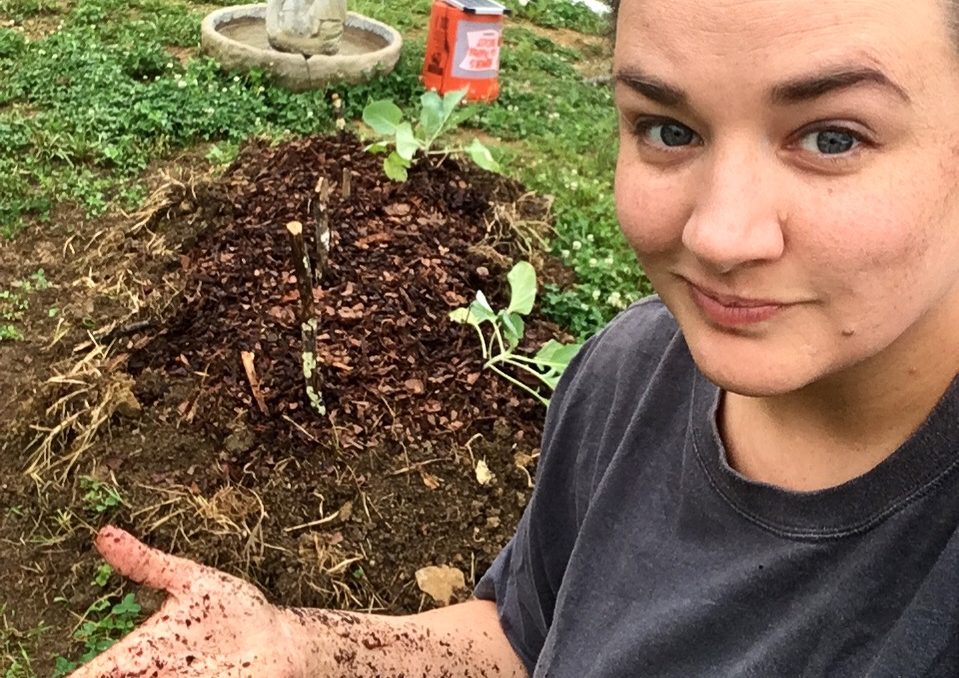
It isn’t enough to have plants, of course. You need some kind of growing medium to put them in. Depending on the amount of space you have to work with and the quality of any existing soil, you may be looking at as little as buying a few bags of potting mix to as much as ordering several tons of compost. No matter what scale you’re working at, here are some simple ways to save money prepping some good soil.
Start your own compost bin or pileThis is probably the most obvious first step. Saving your veggie scraps and other good organic matter like grass clippings, leaf mold, coffee grounds, etc. is one of the easiest ways to get a jump on creating nutrient-dense soil.
You don’t need to buy an expensive bin or tumbler to start composting either. This can be as simple and free as a literal pile in your yard that you turn periodically with a shovel. You can also find some good quality wooden pallets like we did and build an easy compost bin if you have the space.
We noticed a job site near our house had a stack of pallets sitting out recently and we called to see if they would be willing to part with them. The foreman was excited to get rid of them — they were just going to burn them otherwise! We came back with our trailer and hauled away two loads of free, heat-treated, pest-free pallets.
If you do choose to use pallets in your garden projects, make sure you know what to look for so you don’t get something that could leach unwanted chemicals into your soil. Read this post to find out the best and safest ways to get free materials like pallets.
Contact local farmersIt isn’t uncommon for small and independent farmers to have composted manure, mulch, or other amendments available for those who ask. Sometimes, getting those materials is as simple as asking and then coming to pick it up yourself for free. Other times you may have it loaded for a fee. Either way, be sure to take appropriate precautions when using things like manure in the food garden.
Chip Drop
If you need a LOT wood chips to mulch your garden, Chip Drop is a service worth considering. Chip Drop allows gardeners to sign up and receive FREE wood chips from local arborists.
This can be a great option if you need a LOT of wood chips, as typical deliveries range from 4-20 cubic yards depending on availability.
However, deliveries could be made at any time and you won’t be notified beforehand, which could be problematic for folks like us with a long driveway or otherwise tricky property access. The quantity of a delivery could also be an issue for city folks with limited space to receive a drop.
And depending on what type of tree was mulched, you may have to contend with issues like juglone from black walnut trees. Jugalone is a toxic chemical produced by the black walnut and to which many plants are susceptible.
While the trunk and branches typically contain less jugalone than the buds or roots, black walnut mulch still leeches a bit into the soil and can kill nearby plants. Chip Drop allows you to specify which species of trees you do or don’t want, so hopefully you can avoid the issue altogether. Still, it’s worth being cautious.
Tree trimmersIf you don’t have Chip Drop in your area or if it isn’t a good option for you, try contacting local tree trimming companies and asking if they are ever looking to get rid of their wood chips. Contacting them directly can give you more control over when and how you receive mulch.
Municipal compost and mulching programsSome areas have public compost and mulching programs. These are often done through local city or county governments, but can also be private ventures or local cooperatives. For example, one of the cities we lived in before going off-grid had a residential hub where you could bring your own food scraps to add to the compost and receive finished compost to take home. They also mulched trees trimmed by the city as well as residential Christmas trees and would allow residents to collect mulch for home use.
Not every location has programs like these, so check to see if you’re lucky enough to have one near you.
Collect lawn clippings and leavesLawn clippings and leaves are wonderful materials to add to your compost bin or to use as mulch. If adding to compost, be sure not to unbalance your ratio of “green” to “brown” materials too much by having too many grass clippings. Letting your grass clippings dry out can be helpful if you have too much green, for example.
Use wood ash from your stove or fire pitWood ash has myriad uses around the home and garden. I used it quite a lot this year to scrub down my stovetop and oven (and it was the only thing that removed the burned-on crusties!). Wood ash can be added to the compost bin or directly to garden soil. It is alkaline, so it can help where your soil is too acidic.
This helpful post from GrowVeg addresses the use of wood ash in the garden or compost bin.
And if you’re looking for more ways to use wood ash, Ashley over at Practical Self Reliance has over 70 ways to use it around the home!
Coffee grounds from local shopsCoffee grounds are a great soil amendment when you need to increase acidity. But if you don’t drink coffee or don’t have enough grounds for what you want to do, you can often get used coffee grounds from your local coffee shop! Many Starbucks will bag up grounds and offer them for free on a first-come-first-served basis. Smaller local shops will often work with you if you want grounds too. All you need to do is ask!
Contact your nearest zooOkay, this one may sound weird, but if you’re lucky enough to live near a zoo, some will offer composted manure through their horticulture programs. Some are free, while others are paid and go to support zoo operations and conservancy efforts.
Do a search for [YOUR NEAREST ZOO] COMPOST PROGRAM to see if anything is available to the public.
Cheap or Free Garden Beds and Containers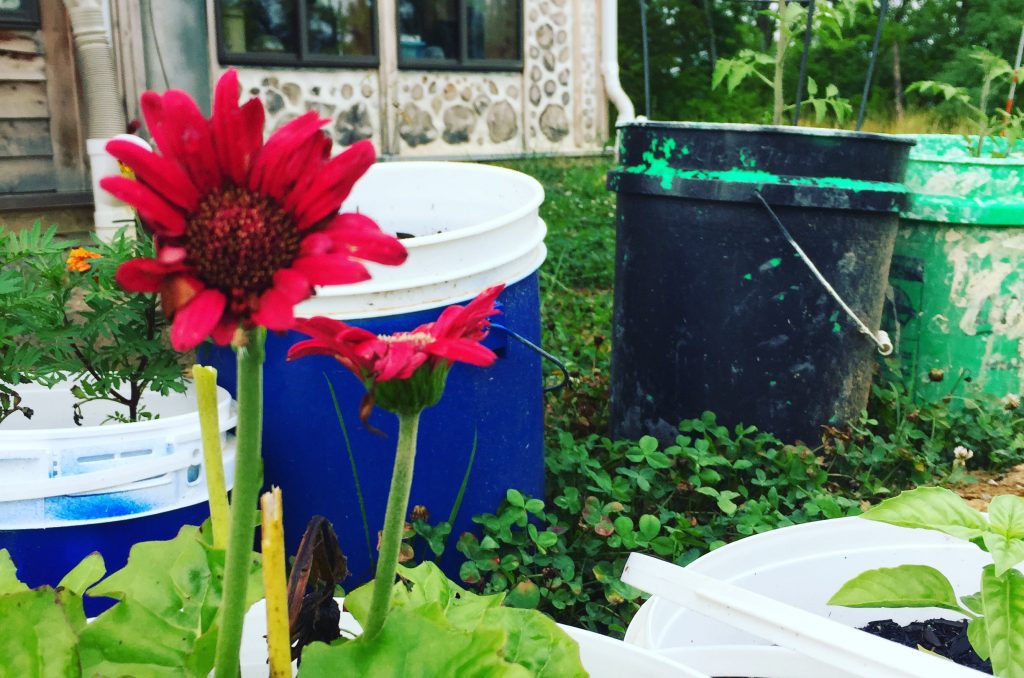
Sure, you can grow directly in the dirt. But if you’re in a situation where you don’t have land to grow on, need raised beds, or only have time and space for buckets, there are loads of inexpensive or free ways to get what you need. And even if you are lucky enough to have land to grow on, you may still have situations where a container or raised bed would be a better option. Here are some ideas to get started.
Use materials you have on hand
I’m a big fan of “shopping at home”. This means looking at what you already have on hand and getting creative with how you use it. For example, I have a TON of rocks on my property, so I stacked them to create raised beds. My friend has bamboo growing in her backyard and she used it to create raised beds.
Folks have made gardens out of everything from discarded tires to gutters to wash tubs. Look at what you have, use items and resources creatively, and then purchase what you need to fill in the gaps.
Discards from hardware storesHardware stores often discard materials that aren’t fit to sell for full price. Sometimes the discards are sold on clearance, and other times they’re simply thrown out. This can be anything from lumber to hardware to household items.
If you’re lucky enough to find good clearance items, think of ways to use them creatively in the garden. For items that are destined for the dumpster, check with a manager to arrange a time to pick them up. Like with the discarded plants, some managers are more than happy to make arrangements with you. It feels more legitimate than dumpster diving too.
Some people really get into dumpster diving, but laws vary from place to place. It carries its own risks, so do your research. As for me and my house, we’ll speak kindly to a manager.
Reuse storesReuse stores are one of my all-time favorite places to get anything from building materials like lumber to garden planters and more. Habitat for Humanity runs ReStores which offer a wide variety of items at a steep discount. You may also come across independent building reuse or overstock stores locally. Do a search to see what is in your area.
RELATED: 9 WAYS TO GET BUILDING MATERIALS CHEAP OR FREE
Use unconventional containersGardens are not limited to the traditional raised bed or buckets. I have grown and have seen gardens grown in things like:
- wash basins
- bathtubs
- gutters
- jars
- cans
- old coffee pots
- boots
- baskets
- pitchers
- tires
- crates
- etc.
Look at what is available. Can it hold soil? Can you add drainage if needed? Get creative!
Get buckets from bakeries and delisOne of my favorite ways to get buckets for raised beds or DIY compost bins is from bakeries and delis. Like some of our other methods, this requires you to ask an employee for what you want. Typically, I’ll ask whoever is at the counter if they are willing to give away used food-grade buckets. Often, the answer is yes.
They’ll usually tell me what day of the week they get their shipments and when the buckets are emptied. Sometimes they have to send the buckets back to the companies that originally filled them, but sometimes they’re destined for the trash unless you come along to rescue them!
Most of the buckets I have collected were once used to hold things like buttercream frosting or pickles. I have a post here about how we took dozens of free buckets from the grocery store and used them for some budget-friendly container gardening.
READ: How to Make a Container Garden on the Cheap
Use pallets (safely!)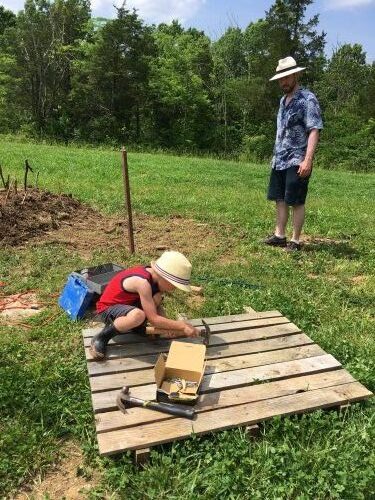
Last but not least, you can use pallets in the garden for all kinds of things! Pallets can be used to create things like:
- compost bin
- raised beds
- planter boxes
- vertical garden
- trellis supports for vining plants
- fencing
- cold frames
- and more!
If you’re going to use old pallets, you need to do it safely. Look for pallets marked KD (kiln dried) or HT (heat treated). Avoid pallets marked MB, as those have been chemically treated with methyl bromide. Also try to avoid pallets that may have come into contact with harmful chemicals or other contaminants during the shipping process.
You can read more about sourcing and safely using the best reclaimed and recycled materials like pallets in this post.
READ: How to Safely Find and Use Reclaimed and Recycled Materials
There you have it!
Over 30 of our best tips to help you create a thriving garden even if you don’t want to spend much money. Gardens don’t have to be expensive, and if you’re resourceful you can make a lot happen with what you have.
If you haven’t already, check out these other garden posts for more easy garden ideas and inspiration!
- 12 Essentials for Planning Your Perfect Homestead Garden
- Garden Projects You Can Do For Cheap or Free
- How to Make an Abundant Container Garden For Free
- How to Homestead in the City or Suburbs: 8 Easy Ways to Start
We also have a budget-friendly printable PDF garden planner to help you get your thoughts out of your head and onto paper! Check that out here:

On a SUPER TIGHT budget? Feel free to start with our garden planning starter pack, a FREE PDF download inside our Members-Only Resource Library. You can get access to the lite garden planner, along with all of our other planning guides, by getting on the email list here:
Learn more about our original cordwood homestead project here. And be sure to join us on Pinterest, Facebook, and Instagram for more homesteading goodies that don’t necessarily make it to the blog. Thanks for reading!
